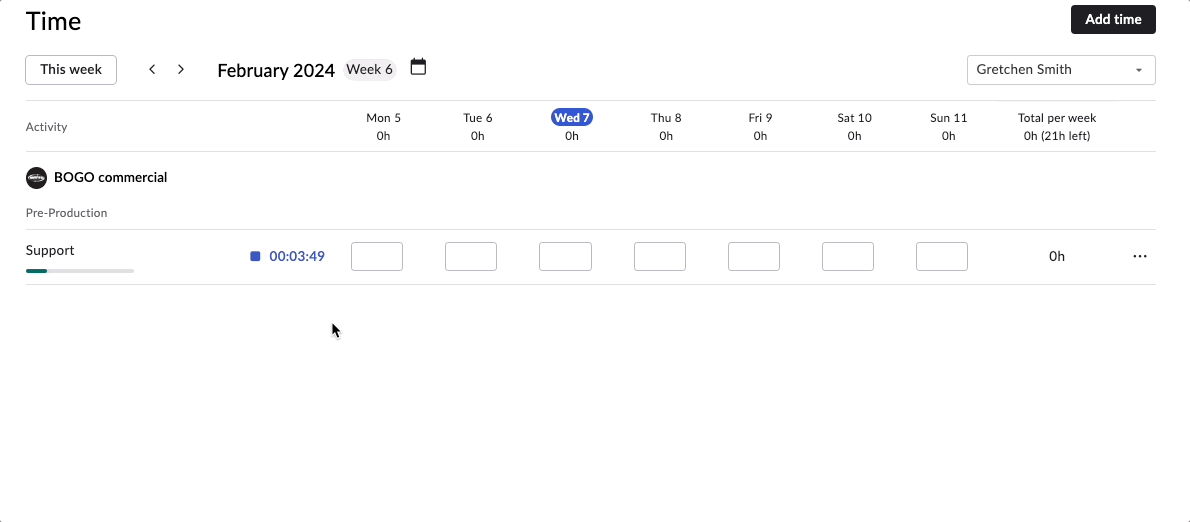How to Create a Winning Marketing Project Plan
Planning for marketing projects can be a large undertaking. A business, whether large or small, relies on marketing to develop its brand image, create awareness, and increase demand for products or services.
Consequently, there is a lot of pressure on marketers to deliver campaigns that improve ROI – and let’s not forget the never-ending demand from stakeholders to “go viral.” That’s why marketing project management, a framework that helps marketers plan, oversee, and deliver on projects is often used as a basis to create successful marketing project plans.
What is a marketing project plan?
A marketing project plan is a document or presentation that details the collection of strategies your marketing team will employ to achieve its goals for an upcoming project or period of time – as well as how you plan to implement them.
Marketing agencies likely work within a project management framework, whereas in-house marketing teams might work on several different initiatives throughout the year.
We’ll get into exactly what you need to include in a marketing project plan later in this blog. That said, marketing plans will also include an overview of your goals, competitors, target market, necessary tasks, KPIs, and timeline.
Why should you create a plan for marketing projects?
How would you otherwise outline goals, define a strategy, and track outcomes without carefully planning for it? Marketing project plans are used to document and clearly illustrate what you are trying to achieve and how.
If your marketing project requires approval, having a thoughtful plan in place means you’ll have a tangible document to send to stakeholders for them to consider – a particularly important part of project-based agency work. For a creative agency trying to win a client bid, a well-drafted marketing project plan and persuasive proposal will help set your agency apart.
Marketing plans are also crucial for in-house marketing teams as it helps marketing managers understand the team’s upcoming activities and how you plan to keep the project on track.
Plus, according to CoSchedule’s 2022 marketing trend report, organized marketers are nearly 7x more likely to report success than their peers – a jump from 3x more likely in 2018. Implementing a project marketing plan is perhaps the best way to ensure your project stays organized.
What is the difference between a marketing strategy and a marketing plan?
Yes, a marketing strategy is different than a marketing plan, although one cannot exist without the other. In essence, your marketing strategy outlines how you plan to achieve your long-term goals and your marketing plan is a detailed account of what low-level tasks need to get done to see the strategy through.
Marketing strategies consist of high-level thinking regarding how you’ll achieve your future goals, maintain your team or company values, and secure a competitive advantage in your efforts.
For example, if you’re tasked with launching a new product by the end of the year, your strategy will include the types of marketing you plan to utilize in order to successfully launch the product. This could include email marketing, social media content, or a video campaign.
On the flip side of things, a marketing plan consists of the day-to-day tasks and actions that must be completed in order to act on your strategy and achieve your long-term goals. Using the previous example, your plan would include actually making the videos in the commercial campaign.
Without a marketing strategy, it will be difficult to plan out your team’s activities, but at the same time, a marketing plan is a very necessary part of carrying out your strategy.
What to include in a project marketing plan
So much goes into planning a marketing project that it can be difficult to know what to include. You want to provide enough details on what your team will be working on, but at the same time, you don’t want to leave your audience feeling overwhelmed.
Here’s a look at the main points you should make sure your plan includes:
1. Executive summary
If you’ve ever written a business plan before, you’re likely familiar with what goes into an executive summary. In essence, this is a short summary overview of the contents of your plan so that readers are briefed on your overall vision before diving into the details.
Although this section should come at the very beginning of your plan, some might find it easier to write it once you’ve completed the rest of the plan, since that’s when you’ll have already thought through the particulars of each section.
2. Goals
Project goals are the backbone of your marketing plan, as they act as a sort of north star that guides the direction of your activities.
Every team might have a different preference for the framework they prefer to use to set goals. Some utilize Objectives and Key Results (OKRs), whereas others rely on SMART goals – meaning they set goals that are Specific, Measurable, Achievable, Realistic, and Time-related.
Regardless of the method you use, your goals should be clear in order to clearly define what the team should be working on. Failure to set goals that are both realistic and achievable can cause your team to fall short and waste resources on work that isn’t furthering your main objectives.

3. Strategies
Your marketing strategies are the ways you plan to achieve your goals. For instance, if your goal is to launch a campaign that results in a sold-out product launch, your strategies include how you’ll do that – whether through paid advertising, sponsored social media posts, or blog content.
Before you can kick off your marketing project or campaign, it’s critical to have a clear picture of your brand’s messaging. This includes your mission statement, positioning, as well as the value proposition that sets you apart from competitors. Putting these into writing helps establish a strong foundation for your team to work off once the project begins.
4. Marketing team
For in-house marketing teams, it might already be clear who will be working on this specific project. But if not, this is the part of the plan where you should introduce the team who will help achieve the project goals.

5. Target market
Building a winning marketing project plan involves a hefty amount of market research, including research on your target market. After all, how are you supposed to successfully launch a marketing campaign without knowledge of the behaviors of your target audience?
Depending on your goals and objectives, this part of your marketing plan can look several different ways. For example, if your marketing campaign revolves around the launch of a new product, you’ll want to outline your Ideal Customer Profiles (ICPs).
Creating customer personas involves considering your target buyer’s occupation, demographic information, pain points, and how your product can remedy those pains. Compiling ICPs and personas can be immensely helpful in helping you craft persuasive marketing messaging.

6. Competitive analysis
The best way to determine how your marketing campaigns can stand out is by examining what your competitors are doing. For a new product launch campaign, you’ll want to look at what types of marketing messages are currently working for them as well as what they’ve previously tried. How can your brand differentiate itself in order to stand out?
If you’re looking to utilize SEO to launch your new product, analyze the content of your competitors that are currently ranking for the keywords you’re targeting. Examine the health of their website while considering gaps in your own strategy.
For example, if your marketing campaign focuses on social media, examine what mediums your competitors are using. Are they active on TikTok, or is short-form social content an area in which there’s an opportunity to stand out? Is it standard for your competitors to post daily, or do they have a slower posting cadence?
7. Budget and resource allocation
A marketing project plan without a budget estimate would be incomplete. After all, it’s difficult to know if your goals are within reach unless you know how much it will cost to execute your plans.
In-house marketing teams likely won’t need to incorporate their labor costs into their budget, but agencies that bill clients hourly or work with retainers will need to factor in the cost of their labor, which may require more extensive budget planning.
Also read: 8 Steps to Track Project Budgets (and Maximize Profits)
Other common costs for marketing budgets include PPC campaigns, sponsored social media posts, focus groups, and outsourced graphic design, among many other potential costs.
Many project management software tools are able to help speed up your budgeting processes and reduce your administrative burden. Other teams prefer to budget the old-fashioned way with the help of simple spreadsheet templates for budgeting.

8. Timeline of tasks
Having your goals and strategies in place is one thing, but executing them is an entirely different challenge. This is why it’s helpful to create a list of tasks that need to be completed as well as a timeline of when they’ll be completed and include both in your marketing project plan.
This information helps make your plan actionable, as it clearly outlines what’s needed of the team to see the project plans through to completion. Presenting everything in a timeline format helps clients, stakeholders, or executive managers have a better idea of when certain milestones will be completed and ask for timelines to be moved up if necessary.
Once again, project management software solutions are well-equipped to help you manage and execute your projects. Many tools – such as Rodeo Drive – allow you to assign tasks to marketing team members based on their current workload, which prevents you from overburdening them as the project progresses.
9. Metrics for measurement
The best way to measure whether your marketing campaigns were successful is to outline KPIs and specific metrics for success.
The metrics you’ll want to employ will obviously differ based on your project objectives. For example, if your goal is to drive traffic to your website using a content marketing strategy focused on new blog content, you might want to consider measuring pageviews, click-through rates, and keyword rankings during a particular period.
Alternatively, if your marketing campaign is centered around a webinar event, perhaps you’ll want to examine the Net Promoter Score (NPS), qualified leads in attendance, or the total number of customers acquired as a result of the event.
Regardless of the metrics you select, including them as part of your marketing plan will help you track your success as the project progresses, in addition to helping the project team understand what success should look like at the conclusion of the project.

The role of a marketing project manager
Leading a marketing team is no easy task. In addition to ensuring the marketing campaign is successful, the project manager is in charge of managing the project scope, making sure the team has enough resources, and balancing the needs and demands of stakeholders.
Wearing so many different hats during the project requires project managers to possess a variety of soft and hard skills. Critical thinking, communication, time management, and conflict resolution are typically some of the most necessary skills, in addition to adaptability, since it’s unlikely that the project will go exactly as planned.
That said, marketing is at the core of your project plan, so it’s essential that your project manager has experience successfully completing and managing marketing projects as well.
Related: 12 Ways to Improve Team Accountability [Remote & Onsite]
How to create a marketing project plan in 6 steps
Now that we’ve covered everything that goes into a marketing project plan, you might be wondering in what order you should tackle each part of the plan. In general, you can follow these 6 steps to create a comprehensive marketing plan:
Step 1: Identify your stakeholders
Your stakeholders are the target audience for your marketing project plan, which is why it’s important to consider their needs and demands before you even begin compiling your plan.
If you work for an agency, your stakeholders might include the actual client that’s paying for your services, but for an in-house team, stakeholders typically include company executives who you’ll need to report. Overall though, stakeholders include anyone with a vested interest in your project or campaign.
If you know your stakeholders are extremely budget sensitive or extremely focused on one part of the project, you’ll want to give those items extra attention in your plan.
Also read: 15 Marketing Agency Software To Use in 2023
Step 2: Assemble your team
The question of who’s going to work on your project is an important one. Some project objectives might require team members with skills and experience beyond that of your current team.
For example, if your campaign has a PR component and no one on your team has experience placing articles in sought-after publications, perhaps you’ll want to point out this gap to stakeholders and pitch a third-party PR firm to help out.

Step 3: Build a project communication plan
Poor communication causes projects to fail. Luckily, you can prevent this from happening by creating a communication management plan.
This document should outline how often communication will occur and through which channels. That way, stakeholders know how often they should expect to hear updates on project progress, and marketing team members understand how often they should communicate their progress. Maybe updates will occur through a weekly email, or perhaps through a quarterly meeting.

Step 4: Write down all required tasks
The best way to illustrate that a plan is actionable and achievable is by noting what needs to get done to complete the project. Not only will this help you once it’s time to assign tasks to your team members, but it will give your stakeholders a better idea of what the team will be working on.

Step 5: Finalize your schedule
Your marketing plan should preemptively answer the questions you anticipate your stakeholders will ask. “When will the marketing campaign be completed?” is inevitably a question you’ll hear them ask.
As such, after you’ve created a list of tasks that need to get done, it’s wise to finalize a timeline. This will help ensure everyone is on the same page regarding deadlines, and stakeholders can let you know immediately if the timeline needs to be adjusted.
Step 6: Compile a risk management plan
Risk management is sometimes overlooked by marketing project managers until it’s too late. This process involves identifying, evaluating, and monitoring risks that can interfere with the team’s ability to complete the project.
Project risks can include a range of things, including everything from one of your team members going out on maternity leave to the unpredictable availability of certain resources you can’t complete the project without. Giving some thought to these potential risks ahead of time allows you to be better prepared to handle them, should they occur.
Ace your marketing projects with Rodeo Drive
It’s no secret that marketing project planning can be challenging. Surprisingly, 65% of marketers don’t use a project management software, despite the fact that those who do are 4x more likely to report success than their counterparts.
That’s why we created Rodeo Drive – an all-in-one project management software tool built with the needs of creative teams in mind. Rodeo Drive makes it easier than ever for marketers to access all of the project management features they need – all in one place. Users can build budgets, send estimates and invoices, and track their time directly from the platform.

The best part is, all of Rodeo Drive’s features are interconnected, meaning your budget will update in real time as your team records their hours worked. This means you’ll instantly know when your projects go over budget, and Rodeo Drive’s reports give you insights on things like your project profitability and employee productivity.
All in all, Rodeo Drive allows you to spend more time doing what you do best – creating successful marketing campaigns.
Why not see if Rodeo Drive can make your life easier? Get started for free.








